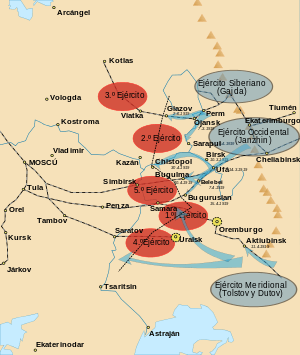Spring Offensive of the Russian Army (1919)
| Spring Offensive of the Russian Army | |||||||
|---|---|---|---|---|---|---|---|
| Part of the Russian Civil War | |||||||
 Map of the Spring Offensive of the Russian Army | |||||||
| |||||||
| Belligerents | |||||||
|
|
| ||||||
| Commanders and leaders | |||||||
|
|
| ||||||
| Strength | |||||||
|
111,000 men 379 guns |
113,000 men more than 200 guns | ||||||
The Spring Offensive of the Russian Army was an offensive of the Russian Army of the White movement led by Alexander Kolchak on the Eastern Front of the Russian Civil War between March and April 1919.
Background
At the end of the year 1918, the situation on the Eastern Front of the Russian Civil War was unclear. Both sides fought for the Kama river. Supreme Command of Reds prepared for the great fights on the Southern and Western fronts, hence there were no supplies for the Eastern front. At the end of December Whites conquered Perm on the northern flank, but Reds captured Ufa on the southern flank. On 22 January 1919 Red's 1st Army connected with Turkestan Army, advanced from the Middle Asia; on 24 January Red's 4th Army captured Uralsk.
At the beginning of 1919 Supreme Command of Whites decided to advance on two directions. The purpose of northern advancing was to connect with North Russia Front and to strike on Petrograd; the purpose of southern advancing was to crush the front of Reds on the middle Volga river and to strike on Moscow. Whites had three armies: Siberian Army (52,000 men, 83 guns, commander - Radola Gajda) on the northern flank between Glazov and Perm, Western Army (48,000 men, 120 guns, commander - Mikhail Hanzhin) in the middle between Birsk and Ufa, cossacks (11,000 - 13,000 men) on the southern flank. Reds had 4th Army (commander - Mikhail Frunze), Turkestan Army (commander - Georgii Zinoviev) and 1st Army (commander - Gaya Gai) in the region to the north of Caspian Sea (52,000 men, 200 guns and 613 machineguns in common), to the north of them on 200 km front there were 10,000 men, 42 guns and 142 machineguns of 5th Army (commander - Jan Blumberg); near Sarapul located 2nd army (22,000 men, 70 guns and 475 machineguns, commander - Vasilii Shorin), near Perm railway - 3d Army (27,000 men, 69 guns and 491 machineguns, commander - M.Lashevich, since 5 March - Sergei Mezheninov). Therefore, on the northern flank both sides were equal, Whites prevailed in the middle (49,000 men of Hanzhin against 10,000 men of Red's 5th Army) but Reds had an advantage on the southern flank (52,000 men of Reds against 19,000 men of Whites). Both sides decided to strike by the right flank (Whites - by right flank and center) and to cut the communication lines of the opponent's left flank. At the end of February Whites pushed left flank of Red's 2nd Army, forced it to retreat.
Offensive
On 4 March, Siberian Army of Whites began its advancing. On 8 March it captured Okhansk and Osa and continued its advancing to Kama river. On 9 April they captured Sarapul. On 15 April soldiers of Siberian Army's right flank contacted with detachments of Northern front in rare populated lands near Pechora River.
On 6 March Hanzhin's Army stroke between Red's 5th and 2nd Armies. After four days of fighting Red's 5th Army was crushed, its remains retreated onto Simbirsk and Samara. Reds had no forces to cover Chistopol with its bread storages. It was a strategical breakthrough, commanders of Red's 5th Army fled from Ufa. Whites captured Ufa without fighting on 14 March. On 6 April Whites captured Belebey, later - Bugulma and Chistopol.
After receiving information about crushing the 5th Army, Mikhail Frunze (he became a commander of Southern Army Group of Reds) decided not to advance, but to defend its positions. As a result Reds were able to stop White's advancing on southern flank and to prepare its counteroffensive.
Aftermath
Whites made strategical breakthrough in the center, but Reds were able to prepare its counteroffensive on the southern flank.
Sources
- Н.Е.Какурин, И.И.Вацетис "Гражданская война. 1918-1921" (N.E.Kakurin, I.I.Vacietis "Civil War. 1918-1921") - Sankt-Peterburg, "Polygon" Publishing House, 2002. ISBN 5-89173-150-9